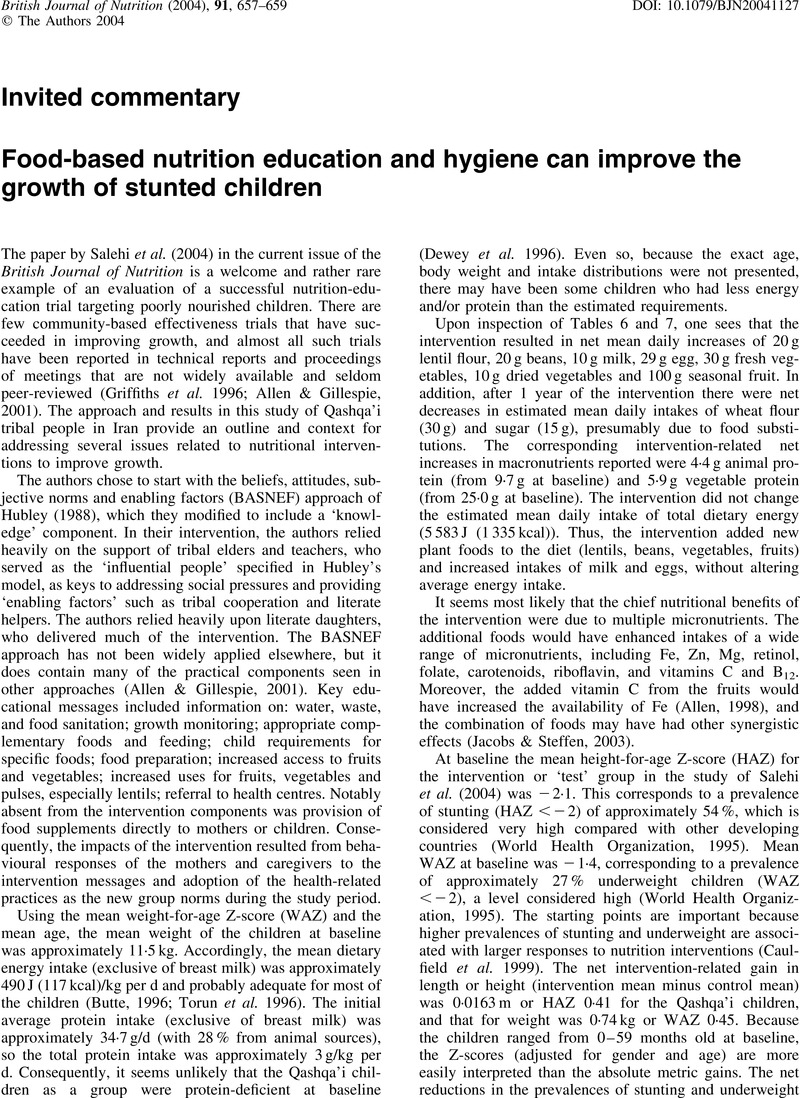No CrossRef data available.
Article contents
Food-based nutrition education and hygiene can improve the growth of stunted children
Published online by Cambridge University Press: 09 March 2007
Abstract
An abstract is not available for this content so a preview has been provided. As you have access to this content, a full PDF is available via the ‘Save PDF’ action button.

- Type
- Invited commentary
- Information
- Copyright
- Copyright © The Nutrition Society 2004
References
Abrams, SA, Mushi, A, Hilmers, DC, Griffin, IJ, Davila, P & Allen, L (2003) A multinutrient-fortified beverage enhances the nutritional status of children in Botswana. J Nutr 133, 1834–1840.CrossRefGoogle ScholarPubMed
Allen, LH (1998) Iron–ascorbic acid and iron–calcium interactions and their relevance in complementary feeding. In Micronutrient Interactions. Impact on Child Health and Nutrition, pp. 11–20. Washington, DC: International Life Sciences Institute.Google Scholar
Allen, LH & Gillespie, SR (2001) What Works? A Review of the Efficacy and Effectiveness of Nutrition Interventions. ACC/SCN Nutrition Policy Paper no. 19. Manila: Asian Development Bank.Google Scholar
Ash, DM, Tatala, SR, Frongillo, EAJ, Ndossi, GD & Latham, MC (2003) Randomized efficacy trial of a micronutrient-fortified beverage in primary school children in Tanzania. Am J Clin Nutr 77, 891–898.CrossRefGoogle ScholarPubMed
Butte, NF (1996) Energy requirements of infants. Eur J Clin Nut 50, Suppl. 1S24–S36.Google ScholarPubMed
Caulfield, LE, Huffman, SL & Piwoz, EG (1999) Interventions to improve intake of complementary foods by infants 6 to 12 months of age in developing countries: Impact on growth and on the prevalence of malnutrition and potential contribution to child survival. Food Nutr Bull 20, 183–200.CrossRefGoogle Scholar
Curtis, V, Cairncross, S & Yonli, R (2000) Domestic hygiene and diarrhoea – pinpointing the problem. Trop Med Int Health 5, 22–32.CrossRefGoogle ScholarPubMed
Dewey, KG, Beaton, G, Fjeld, C, Lonnerdal, B & Reeds, P (1996) Protein requirements of infants and children. Eur J Clin Nutr 50, Suppl. 1S119–S147.Google ScholarPubMed
Esrey, SA, Habicht, JP & Casella, G (1992) The complementary effect of latrines and increased water usage on the growth of infants in rural Lesotho. Am J Epidemiol 135, 659–666.CrossRefGoogle ScholarPubMed
Feacham, RG (1984) Interventions for the control of diarrhoea diseases among young children: Promotion of personal and domestic hygiene. Bull World Health Organ 62, 467–476.Google Scholar
Griffiths, M, Dickin, K & Favin, M (1996) Promoting the Growth of Children: What Works. Rationale and Guidance for Programs. Washington, DC: Human Development Department, The World Bank.Google Scholar
Hoare, K, Hoare, S, Rhodes, D, Erinoso, HO & Weaver, LT (1999) Effective health education in rural Gambia. J Trop Pediatr 45, 208–214.CrossRefGoogle ScholarPubMed
Hubley, J (1988) Understanding behaviour: the key to successful health education. Trop Doct 18, 134–138.CrossRefGoogle ScholarPubMed
Jacobs, DR Jr & Steffen, LM (2003) Nutrients, foods, and dietary patterns as exposures in research: a framework for food synergy. Am J Clin Nutr 78, 508S–513S.CrossRefGoogle ScholarPubMed
Lal, P, Bansal, AK, Aggarwal, CS, Taneja, DK & Gogia, V (1996) Incidence of diarrhoea and some related environmental and behavioural factors in Jhuggis of Delhi. Indian J Public Health 40, 35–37.Google ScholarPubMed
Moffat, T (2003) Diarrhea, respiratory infections, protozoan gastrointestinal parasites, and child growth in Kathmandu, Nepal. Am J Phys Anthropol 122, 85–97.CrossRefGoogle ScholarPubMed
National Research Council (1989) Recommended Dietary Allowances, 10th ed. Washington, DC: National Academy Press.Google Scholar
Nishiura, H, Imai, H, Nakao, H, Tsukino, H, Changazi, MA, Hussain, GA, Kuroda, Y & Katoh, T (2002) Ascaris lumbricoides among children in rural communities in the Northern Area, Pakistan: Prevalence, intensity, and associated socio-cultural and behavioral risk factors. Acta Trop 83, 223–231.CrossRefGoogle ScholarPubMed
Rivera, JA, Gonzalez-Cossio, T, Flores, M, Romero, M, Rivera, M, Tellez-Rojo, MM, Rosado, JL & Brown, KH (2001) Multiple micronutrient supplementation increases the growth of Mexican infants. Am J Clin Nutr 74, 657–663.CrossRefGoogle ScholarPubMed
Rivera, JA, Hotz, C, Gonzalez-Cossio, T, Neufeld, L & Garcia-Guerra, A (2003) The effect of micronutrient deficiencies on child growth: a review of results from community-based supplementation trials. J Nutr 133, 4010S–4020S.CrossRefGoogle ScholarPubMed
Roche, AF & Himes, JH (1980) Incremental growth charts. Am J Clin Nutr 33, 2041–2052.CrossRefGoogle ScholarPubMed
Salehi, M, Kimiagar, SM, Shahbazi, M, Mehrabi, Y & Kolahi, AA (2004) Assessing the impact of nutrition education on growth indices of Iranian nomadic children: an application of a modified beliefs, attitudes, subjective-norms and enabling-factors model. Br J Nutr 91, 000–000.CrossRefGoogle ScholarPubMed
Sandstead, HH, Penland, JG, Alcock, NW, Dayal, HH, Chen, XC, Li, JS, Zhao, F & Yang, JJ (1998) Effects of repletion with zinc and other micronutrients on neuropsychologic performance and growth of Chinese children. Am J Clin Nutr 68, 470S–475S.CrossRefGoogle ScholarPubMed
Stephenson, LS, Latham, MC & Ottesen, EA (2000) Malnutrition and parasitic helminth infections. Parasitology 121, Suppl.S23–S38.CrossRefGoogle ScholarPubMed
Thu, BD, Schultink, W, Dillon, D, Gross, R, Leswara, ND & Khoi, HH (1999) Effect of daily and weekly micronutrient supplementation on micronutrient deficiencies and growth in young Vietnamese children. Am J Clin Nutr 69, 80–86.CrossRefGoogle ScholarPubMed
Torun, B, Davies, PS, Livingstone, MB, Paolisso, M, Sackett, R & Spurr, GB (1996) Energy requirements and dietary energy recommendations for children and adolescents 1 to 18 years old. Eur J Clin Nutr 50 Suppl. 1, S37–S80.Google ScholarPubMed
Walker, SP, Grantham-McGregor, SM, Powell, CA, Himes, J & Simeon, DT (1992) Morbidity and the growth of stunted and nonstunted children, and the effect of supplementation. Am J Clin Nutr 56, 504–510.CrossRefGoogle ScholarPubMed
World Health Organization (1995) Physical Status: The Use and Interpretation of Anthropometry, Report of a WHO Expert Committee. WHO Technical Report Series no. 854 Geneva: WHO.Google Scholar




